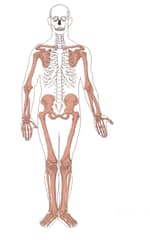Lakhmir Singh and Manjit Kaur Solutions for Exercise 1: Objective Type Questions
Lakhmir Singh Science Solutions for Exercise - Lakhmir Singh and Manjit Kaur Solutions for Exercise 1: Objective Type Questions
Attempt the free practice questions from Exercise 1: Objective Type Questions with hints and solutions to strengthen your understanding. Lakhmir Singh's SCIENCE FOR CLASS 5. solutions are prepared by Experienced Embibe Experts.
Questions from Lakhmir Singh and Manjit Kaur Solutions for Exercise 1: Objective Type Questions with Hints & Solutions
Label the diagram.
Ribcage, skull, limbs, backbone, ball and socket joint, pivot joint, hinge joint and gliding joint.

A framework of bones that give shape and support to our body.
It is the control centre of the human body.
Our nervous system consists of
The coloured part around the pupil in the eyes is
The egg-shaped part of the brain is:
Give reason for the following:
Radha was having a severe cold, she could not smell the different types of flowers.
Give reasons for the following.
There is a pain when the wrist twist or while slipping down if you support your body on the wrist.
